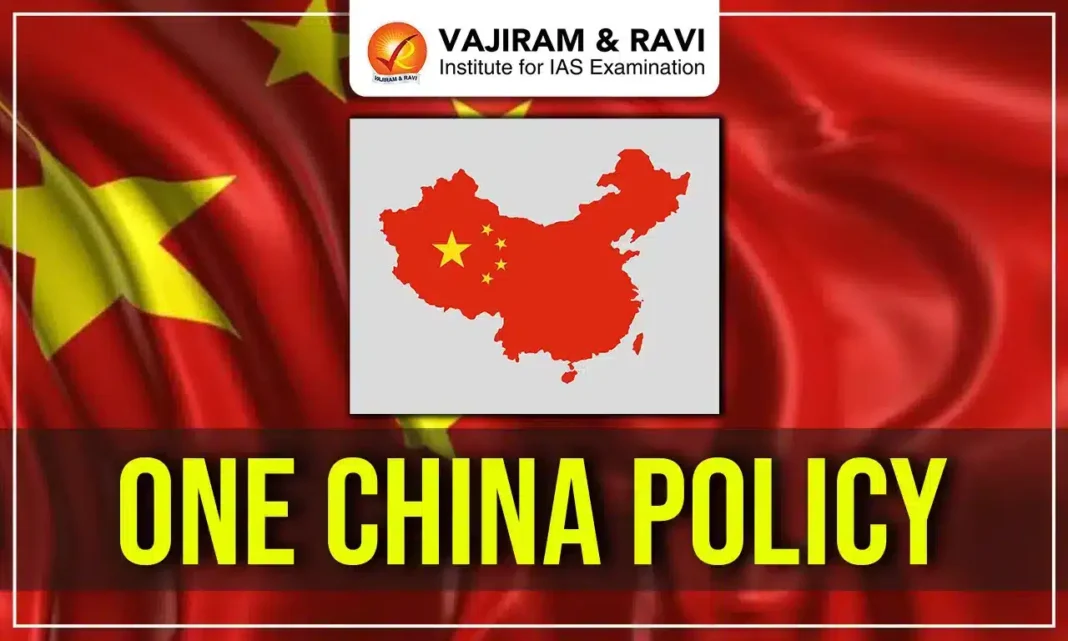One China Policy is the diplomatic recognition of China’s stance that a single government represents the entire country. Check out more about One China Policy.
One China Policy shapes global diplomacy by recognising Beijing as the sole government of China and limiting Taiwan’s formal international status. It is central to major power relations, regional security, and global economic networks, influencing cross-strait dynamics and critical supply chains.
Both the U.S. and India follow the policy with strategic flexibility, maintaining diplomatic ties with China while pursuing unofficial cooperation with Taiwan. India’s approach carefully balances protecting its sovereignty, expanding economic and technological links, and strengthening its role in Indo-Pacific security amid shifting geopolitical challenges.
One China Policy Background
One China Policy originated after the 1949 Chinese Civil War, which led to two rival governments claiming authority over China. The Communist Party established the People’s Republic of China (PRC) on the mainland, while the defeated Nationalists (Kuomintang) withdrew to Taiwan, continuing as the Republic of China (ROC). Both asserted themselves as the sole representative of China.
- Initial Global Recognition: In the early decades, many countries, including the United States, recognised the ROC and refrained from establishing formal ties with the PRC. This dual claim created prolonged diplomatic contestation.
- Shift in the 1970s: Geopolitical realities of the Cold War, along with the US effort to engage Beijing, altered the equation. The landmark UN Resolution 2758 (1971) transferred China’s seat in the United Nations from the ROC to the PRC, consolidating Beijing’s international legitimacy and isolating Taiwan diplomatically.
- China’s Present Position: As of 2025, Beijing views Taiwan as an inalienable part of its territory and strongly resists any attempt at independence. It leverages military deterrence, economic influence, and selective diplomacy to ensure that the principle of “One China” is upheld globally.
One China Policy About
One China Policy is a diplomatic acknowledgement that there is only one sovereign state called “China,” represented by the People’s Republic of China (PRC), and that Taiwan (Republic of China) is part of this single China. Key aspects include:
- Sole Recognition of the PRC: Countries acknowledge Beijing as the sole legal government of China, thereby denying Taiwan any claim to sovereign statehood.
- Diplomatic Exclusion of Taiwan: States adhering to the policy cannot establish embassies, sign treaties, or maintain official state-level relations with Taipei.
- Scope for Unofficial Engagement: Despite no formal recognition, most nations maintain economic, cultural, technological, and trade relations with Taiwan through informal channels.
- One China Policy vs One China Principle:
- One China Policy: It is a stance adopted by foreign governments recognising the PRC while deliberately avoiding Taiwan’s recognition as an independent state.
- One China Principle: It is China’s own position that Taiwan is an inalienable part of its territory, and any challenge to this is interference in its sovereignty.
- Strategic Significance: One China Policy is central to shaping US–China relations, the balance of power in the Indo-Pacific Region, and global economic security, especially in sectors like semiconductor supply chains.
US One China Policy
One China Policy is officially accepted by the United States, by recognising the People’s Republic of China (PRC) as the sole legal government of China. However, Washington interprets and applies the policy differently from Beijing. While China sees it as unconditional recognition of its sovereignty over Taiwan, the U.S. adopts a flexible approach—acknowledging Beijing diplomatically but maintaining robust unofficial ties with Taiwan.
- Dual Commitment: The U.S. recognises the PRC (since the 1979 establishment of diplomatic relations) but, under the Taiwan Relations Act (1979), maintains unofficial ties and provides defensive arms to Taiwan.
- Diplomacy vs. Deterrence: Earlier, Washington emphasised peaceful resolution and engagement with both sides. Today, amid growing rivalry, the focus has shifted toward military deterrence against China.
- Security Dilemma: U.S. support for Taiwan’s self-defence is viewed by China as interference, prompting Chinese military assertiveness and heightening the risk of conflict.
- Strategic Ambiguity: The U.S. continues to avoid openly committing to defend Taiwan, but recent statements and military cooperation signal a stronger tilt toward deterrence.
India and One China Policy
India has been adhering to the One China Policy, reflected in its formal recognition of the People’s Republic of China in 1950. However, since around 2011, the phrase ‘One China Policy’ has not appeared explicitly in official bilateral documents. This shift signals India’s calibrated and changing dynamics of India–China relations.
- Early Recognition and Diplomatic Ties: India recognised the PRC in 1950, closed its consulate in Taiwan, and aligned with the principle of “One China,” formally accepting Beijing as the sole representative of China.
- Shift in Public Reaffirmation: Since the 2010s, India has refrained from explicitly reiterating the One China Policy in joint statements, linking its stance to China’s sensitivity on India’s sovereignty (such as Arunachal Pradesh, Aksai Chin, and PoK).
- Informal Taiwan Engagement: Despite the absence of official diplomatic ties, India maintains an unofficial but growing economic, technological, and cultural exchange with Taiwan, especially in sectors like semiconductors, education, and investment.
- Strategic Balancing: India maintains deliberate ambiguity by diplomatically recognising the PRC but refraining from unconditional support of its political positions. This strategy safeguards India’s territorial claims, sustains economic engagement, and mitigates strategic risks in the Indo-Pacific.
- Security Calculus: India emphasises peaceful solutions in the Taiwan Strait and refrains from taking public positions on Taiwan’s status.
- This enables India to maintain unofficial economic and cultural relations with Taiwan while managing its broader diplomatic relationship with China.
One China Policy Way Forward
One China Policy requires balancing diplomatic ties with sovereignty and strategic interests. The approach should protect territorial claims while enhancing India’s role in Indo-Pacific security.
- Conditional Reaffirmation (Reciprocity Principle): India should reaffirm the One China Policy only if China respects the “One India” Stance.
- This means Beijing must acknowledge India’s sovereignty over Arunachal Pradesh and Ladakh.
- Expand Unofficial but Strategic Taiwan Engagement: India should encourage non-official engagement with Taiwan in trade, technology, and cultural exchanges, navigating diplomatic sensitivities while benefiting economic and strategic partnerships.
- Balancing Diplomatic Recognition: India should maintain diplomatic recognition of the PRC as the sole legitimate government of China, while preserving flexibility in diplomatic engagement with both China and Taiwan.
- Engage in Multilateral Dialogues: India should work through multilateral platforms and regional groupings such as QUAD to balance diplomatic relations and address cross-strait tensions without compromising India’s strategic interests.
- Monitor China’s Policies Actively: India should keep a close watch on China’s evolving policies regarding Taiwan and the Indo-Pacific region, adapting India’s diplomatic and security policies accordingly to safeguard national interests.
One China Policy UPSC PYQs
Question: China is using its economic relations and positive trade surplus as tools to develop potential military power status in Asia”. In the light of this statement, discuss its impact on India as her neighbour. (UPSC Mains 2017)
One China Policy FAQs
Q1. What is the One China policy in simple terms?+
Q2. What is the difference between PRC and ROC?+
Q3. Does India accept the One China Policy?+
Q4. How many countries recognise One China policy?+
Q5. When did the One China Policy emerge?+
Related Posts
Our Latest UPSC Courses

